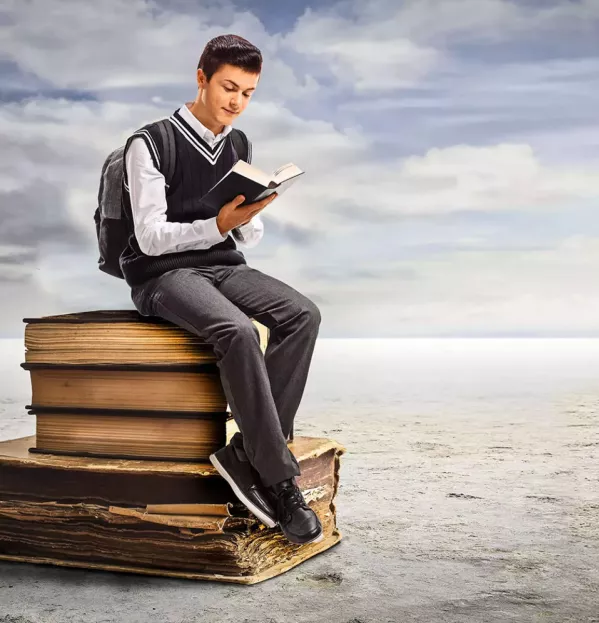
- Home
- Teaching & Learning
- Secondary
- How to get secondary boys reading for pleasure
How to get secondary boys reading for pleasure

This article was originally published on 3 October 2023
Children who choose to read for pleasure experience better academic outcomes and better mental health and wellbeing than those who don’t.
But even for children who start out willing to read, a shift in their perception can occur as they get older: they begin to see reading as an exercise for learning and not as an enjoyable pastime.
Studies have shown that this occurs in both boys and girls, but that boys routinely read less than girls and are more reluctant when it comes to reading for pleasure.
This, along with Ofsted’s most recent inspection framework, which aligns the teaching of reading with the enjoyment of reading, got me thinking about whether secondary schools like mine are overlooking the need to continue fostering a desire to read - particularly in boys - and how we can get better at measuring reading for pleasure.
Three key strands
To understand more about this, I spent a year running a local teacher reading group, drawing on research from the Open University and UK Literacy Association’s Teachers as Readers project.
The group was a forum to explore the project’s findings and discuss how to implement them, specifically the three key strands of developing a learning environment where children are engaged and motivated to read.
These are:
- Teachers’ knowledge of children’s literature
- Teachers’ knowledge of children’s reading practices
- Reading for pleasure pedagogy (reading aloud, independent reading and reading environments)
I also made use of the project’s reading attitudes survey to gather quantitative and qualitative data from a class of 18 Year 8 students, exploring their frequency of reading as well as their motivations for reading, or not.
Drawing on this, I identified a small group of students, including the five most disengaged male readers, who would benefit from targeted intervention.
I had planned to offer library reading sessions to this group and track their reading behaviours over time, but the enforced school closure during the pandemic prevented this.
Nonetheless, the literature review, teacher reading group and attitudes survey still presented some interesting conclusions.
1. We need to make reading a social experience
Firstly, we cannot expect children to like reading simply because they are skilled in its mechanics. We need to find ways to make adolescent reading more socially interactive, rather than a private, passive and potentially isolating experience.
For boys with negative perceptions of themselves as readers, we need to create opportunities for them to explore their own reading identities in supportive, social environments.
2. We need to broaden our definition of ‘reading for pleasure’
We must also reconsider which texts are involved in reading for pleasure.
At a secondary level, we tend to privilege fiction, thereby relegating non-fiction texts, comics, magazines and other picture fiction. In doing so, we are potentially misreading the gender gap. Perhaps it’s not that boys don’t like reading, but that they don’t like the reading that is being offered to them.
It’s important to bear in mind that digital methods of reading and using devices such as e-readers, tablets and audiobooks might not only foster faster engagement but could even act as an antidote to the perceived “digital distraction”.
Read more:
- Teenage reading: 5 things schools need to know
- Reading for pleasure: does it boost reading ability?
- How ‘faster read’ lessons can boost reading
To put these two findings into practice, I have restructured our weekly reading lessons for key stage 3 students to move away from silent, independent reading and towards the creation of a reciprocal reading environment.
Each lesson incorporates a starter question that explores aspects of reading identity (where do you most like to read and why? What makes reading non-fiction different from reading fiction?) followed by a shared read, using a range of engaging and diverse picture fiction and non-fiction reads purchased for our faculty lending library.
Reading lessons always allow time for independent reading, but students can now read together, dip into a magazine or comic or read on their own, and we always take time at the end to share what we have been looking at.
A winning battle
So, how well are the new approaches working? In my KS3 lessons, students - including the boys - feel more confident in sharing their recommended reads and engaging in our regular “Big up your book” or “book battle” activities, in which students introduce a book and the class votes on one to hear a snippet from.
The students also enjoy that their reading agency is valued and that they have free choice over what they read. In short, I’ve observed engagement and enjoyment in reading grow.
However, there is still more work to do. I continue to develop my research in this area and lead the local teacher reading group to support colleagues in developing their own research-informed practice and reflecting on their approaches to nurture this critical area in secondary spaces.
Hannah Grace is key stage 3 curriculum lead for English at Windsor High School and Sixth Form, which is part of the Windsor Academy Trust
You need a Tes subscription to read this article
Subscribe now to read this article and get other subscriber-only content:
- Unlimited access to all Tes magazine content
- Exclusive subscriber-only stories
- Award-winning email newsletters
- Unlimited access to all Tes magazine content
- Exclusive subscriber-only stories
- Award-winning email newsletters
You need a subscription to read this article
Subscribe now to read this article and get other subscriber-only content, including:
- Unlimited access to all Tes magazine content
- Exclusive subscriber-only stories
- Award-winning email newsletters
- Unlimited access to all Tes magazine content
- Exclusive subscriber-only stories
- Award-winning email newsletters



